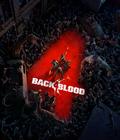For the most part, one of the laments about Valve games is that it tends to not revisit its worlds, even if fan demand is at a fever pitch. One of the series that it has left fallow is Left 4 Dead, and while the second game recently got a surprise update, there hasn't been an official new game since 2009. The developer of the original game, Turtle Rock Studios, has since left Valve's employ, and while it tried a few different things like some VR games and Evolve, it's back in its wheelhouse with Back 4 Blood.
It only takes a few minutes to see that the mechanics of Left 4 Dead 2 are pretty much taken wholesale in Back 4 Blood. For the most part, your party of four needs to make it from one safehouse to another while battling a menagerie of the walking dead. You have a standard assortment of firearms, like assault rifles and shotguns to deal with the undead, but you can also grab melee-specific weapons like machetes and nail-studded baseball bats to do the work when ammo runs out. Aside from battling regular zombies, you'll also face off against others that seem very familiar in all but name. In the alpha build, that included big hulking beasts that vomit bile and whose guts attract more zombies to the area, zombies with a giant clubbing arm, and those that stick to walls and spit incapacitating liquid.
Play through a few minutes of the game, and you'll see that Turtle Rock still has the magic when it comes to the four-player co-op experience. There's a nice balance between the enemy population and your overall survival rate, so shootouts can feel overwhelming but fair. The Director feature stands out as a big reason why the formula still works; the subtle changes ensure that the game achieves an action-packed pace and has enough visible differences to make replays worthwhile. The only thing missing so far is real character interaction, like little quips and barbs that make each player feel like they're more than just an avatar, but we expect that to happen in later builds once the game narrative is further fleshed out.
Instead of adopting the Left 4 Dead formula and calling it a day, the team has made some changes and additions that can give Back 4 Blood some long-term legs. One minor thing is that you have iron sights for all of your guns. It feels like it's there for people who are getting into this genre for the first time, as those players would be taken aback if you couldn't aim, but most players will likely shoot from the hip since there are way too many targets. There's also a brand-new zombie type called the ogre, which feels like a traditional boss since it's a towering beast with a health bar. It remains to be seen whether this creature will be relegated to a set piece or if it will appear everywhere. It's an exciting battle since it's as tall as a building, gives chase, and can only fit its massive arm through doorways.
A more significant change comes from how the game seems to take elements from the likes of competitive team-based shooters. The characters you choose from are no longer blank avatars; they come with specific traits, like faster running speed or more health. While you can't level up the characters, you can give them more weapons or gun attachments with currency earned for completing feats between safehouses. It makes the game more complex, but it's welcome since you know that you can enter a safehouse shorthanded but exit stronger.
The most jarring but welcome change is in the card system, which plays similarly to what you'd find in a game like DOTA2 or League of Legends. The beginning of a run has the game reveal two cards that activate traits that work against your team, like adding a permanent fog to the level or having the zombies run faster. Conversely, you and your team can play cards that act as benefits for everyone, such as having some health replenished with melee kills or increased resistance to fire damage. Completing a leg of the run allows the sequence to stack, with the game adding in one more card and the players each throwing in another card that they've either discovered during the run or already had in their decks. If you lose, you have the chance to throw in one card each without the game doing the same. Alongside the Director, this makes each run wildly different and potentially increases the urge to try again.
The presentation is rather nice, but the title seems to need more optimization or is capable of pushing Unreal Engine 4 to the limits. This comes through when your screen is flooded with zombies and the frame rate stutters and drops to the high 30s, even when using a RTX 3080 and a Ryzen 5 2600 at 1080p. It doesn't happen too often, but it is surprising to see it occur at all. The character models for the humans look about as nice as you would expect from the engine, and the zombies look similar, albeit more grotesque. The environments are fine, but little details make a positive impression, such as the splintering of doors or the presence of blood on your character after going through the zombie hordes.
At the moment, Back 4 Blood is a game for those who want what is essentially a spiritual sequel to Left 4 Dead. While the card system does a great job to further randomize each run and the characters have more than just cosmetic differences, it is the classic core gameplay that will entice people to put down the classic co-op zombie shooters. There's plenty of time before this title is released in June 2021, so we're hoping to get more time with future builds to see how it's evolving.
More articles about Back 4 Blood










 Back 4 Blood is a co-operative FPS designed from the ground-up as an original, premium title and marries the best of what made Left 4 Dead so successful, with new features and state-of-the-art technology.
Back 4 Blood is a co-operative FPS designed from the ground-up as an original, premium title and marries the best of what made Left 4 Dead so successful, with new features and state-of-the-art technology.




